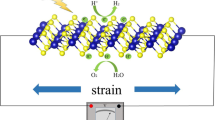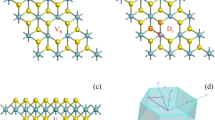Abstract
Context
Monolayer NbS2 is a promising new two-dimensional material, and it is critical to develop effective methods to make NbS2 a material for nanodevices and photovoltaic applications. This study studied the strain rule of sulfur-deficient NbS2 structure by first principles. The results show that all defect structures introduce impurity states to enhance electron transport. The disulfide defect structure produces an indirect band gap under the action of tensile strain, which can reach up to 0.56eV and become a diluted semiconductor. The hybrid NbS2 exhibits high transparency under infrared, visible, and low-frequency ultraviolet light, improving the material’s transmittance, optical response, and catalytic activity. The research results of this paper will provide a basis for the subsequent research of single-layer NbS2 and accelerate the research process of NbS2 as a new semiconductor material.
Methods
We are on the surface perpendicular to the 3×3×1 NbS2 and use a 15 Å vacuum layer to avoid interacting with periodic images. The first-principles simulation uses the CASTEP module in Materials Studio to simulate the hypothetical model and relaxation optimization structure of single-layer NbS2 under strain and defect state. The calculation function is PBE (Perdew-Burke-Ernzerhof) function under the generalized gradient approximation (GGA) for an approximate calculation to describe the interaction between electrons and the interaction between electrons and ions. The pseudopotentials of 3s23p4 and 4d45s1 valence electron configurations were used for S and Nb atoms, respectively. Van der Waals correction is considered in the simulation process.
Moreover, it includes spin-orbit coupling (SOC) effects. For the plane wave truncation energy, we set it at 500eV. The arrangement of the Brillouin area is divided by 6×6×1 gamma-centered Monkhorst-Pack grids. The lattice deformation of all hybrid structures is less than 0.05 Gpa, and the interatomic force is less than 0.03 eV/Å.









Similar content being viewed by others
Data availability
N/A.
Code availability
N/A.
References
Wang QH, Kalantar-Zadeh K, Kis A et al (2012) Electronics and optoelectronics of two-dimensional transition metal dichalcogenides. Nat Nanotechnol 7(11):699–712
Chhowalla M, Shin HS, Eda G et al (2013) The chemistry of two-dimensional layered transition metal dichalcogenide nanosheets. Nat Chem 5(4):263–275
Zhang ZY, Si MS, Wang YH et al (2014) Indirect-direct band gap transition through electric tuning in bilayer MoS2. J Chem Phys 140(17):174707
Kou L, Tang C, Zhang Y et al (2012) Tuning magnetism and electronic phase transitions by strain and electric field in zigzag MoS2 nanoribbons. J Phys Chem Lett 3(20):2934–2941
Conley HJ, Wang B, Ziegler JI et al (2013) Bandgap engineering of strained monolayer and bilayer MoS2. Nano Lett 13(8):3626–3630
Castellanos-Gomez A, Roldán R, Cappelluti E et al (2013) Local strain engineering in atomically thin MoS2. Nano Lett 13(11):5361–5366
Zhou Y, Yang P, Zu H et al (2013) Electronic structures and magnetic properties of MoS 2 nanostructures: atomic defects, nanoholes, nanodots and antidots. Phys Chem Chem Phys 15(25):10385–10394
Cao D, Shen T, Liang P et al (2015) Role of chemical potential in flake shape and edge properties of monolayer MoS2. J Phys Chem C 119(8):4294–4301
Yun WS, Lee JD (2015) Strain-induced magnetism in single-layer MoS2: origin and manipulation. J Phys Chem C 119(5):2822–2827
Ahmad S (2020) Strain and electric field dependent variation in electronic and thermoelectric properties of PtS2. Results Phys 17:103088
Chen X, Wang G (2016) Tuning the hydrogen evolution activity of MS2 (M= Mo or Nb) monolayers by strain engineering. Phys Chem Chem Phys 18(14):9388–9395
Wang D, Yang L, Cao J (2021) Thermal properties of monolayer MoS2 and WS2/MoS2 heterojunction under three strain states. Chem Phys 549:111260
Wang D, Yang L (2022) Photoelectric properties and stability of the single-layer transition metal dichalcogenides under three stress states. Modern Phys Lett B 36(01):2150532
Bafekry A, Faraji M, Fadlallah MM et al (2021) Prediction of two-dimensional bismuth-based chalcogenides Bi2X3 (X= S, Se, Te) monolayers with orthorhombic structure: a first-principles study. J Phys D: Appl Phys 54(39):395103
Ni JJ, Yang L, Zheng W et al (2022) Effect of strain on the electronic and optical properties of (non-) metal adsorbed NbS2 monolayer. J Phys: Condens Matter 35(4):045501
Abdulameer MJ, Abed Al-Abbas SS, Jappor HR (2021) Tuning optical and electronic properties of 2D ZnI2/CdS heterostructure by biaxial strains for optical nanodevices: a first-principles study. J Appl Phys 129(22)
Almayyali AOM, Jappor HR, Muhsen HO (2023) High hydrogen production in two-dimensional GaTe/ZnI2 type-II heterostructure for water splitting. J Phys Chem Solids 178:111317
Tareq S, Almayyali AOM, Jappor HR (2022) Prediction of two-dimensional AlBrSe monolayer as a highly efficient photocatalytic for water splitting. Surf Interfaces 31:102020
Zhao X, Liu X, Wang T et al (2017) Effect of structural defects on electronic and magnetic properties in pristine and Cr-doped HfS2 monolayer. J Alloys Compd 731:303–309. https://doi.org/10.1016/j.jallcom.2017.10.014
Wang X, Zhang Y, Si H et al (2020) Single-atom vacancy defect to trigger high-efficiency hydrogen evolution of MoS2. J Am Chem Soc 142:4298–4308. https://doi.org/10.1021/jacs.9b12113
Chen JH et al (2010) Density functional theory of effects of vacancy defects on electronic structure and flotation of galena. Chinese J Nonferrous Met 20(9):1815–1821
Reshak AH, Auluck S (2005) Full-potential calculations of the electronic and optical properties for 1T and 2H phases of TaS2 and TaSe2. Phys B 358(1-4):158–165. https://doi.org/10.1016/j.physb.2005.01.051
Heine T (2015) Transition metal chalcogenides: ultrathin inorganic materials with tunable electronic properties. Acc Chem Res 48(1):65–72
Perdew JP, Burke K, Ernzerhof M (1996) Generalized gradient approximation made simple. Phys Rev Lett 77(18):3865
Mortensen JJ, Hansen LB, Jacobsen KW (2005) Real-space grid implementation of the projector augmented wave method. Phys Rev B 71(3):035109
Kresse G, Joubert D (1999) From ultrasoft pseudopotentials to the projector augmented-wave method. Phys Rev B 59(3):1758
Serrano RP, Siguero AM, Leal MP et al (2015) CP-132 Impact of implementing a carbapenem stewardship program. Eur J Hosp Pharm 22:A53
Bhandavat R, David L, Singh G (2012) Synthesis of surface-functionalized WS2 nanosheets and performance as Li-ion battery anodes. J Phys Chem Lett 3(11):1523–1530
Tao PC, Yan H, Zhou XH et al (2017) First principles investigation of the tuning in metal-MoS interface induced by doping. Acta Phys Sin 66(11):367–374
Ramasubramaniam A, Naveh D (2013) Mn-doped monolayer MoS2: an atomically thin dilute magnetic semiconductor. Phys Rev B 87(19):2624–2628
Wang D, Yang L, Cao J (2021) First-principles study on the magnetic properties of IB group transition metal-doped MoS2. Mod Phys Lett B 35(11):2141002
Xue X, Wang X, Song Y et al (2018) Electronic structure of transitional metal doped two dimensional 1T-TaS2: a first-principles study. J Alloys Compd 739:723–728
Zhou Y, Wang Z, Yang P et al (2012) Tensile strain switched ferromagnetism in layered NbS2 and NbSe2. Acs Nano 6(11):9727–9736
Cheiwchanchamnangij T, Lambrecht WRL, Song Y et al (2013) Strain effects on the spin-orbit-induced band structure splittings in monolayer MoS2 and graphene. Phys Rev B 88(15):155404
Tianmin L et al (2015) Effects of vacancy defects on electronic structure of monolayer MoS2. Rare Met Mater Eng 44(03):608–611
Bao J (2022) Y ang L, Wang D. Influence of torsional deformation on the electronic structure and optical properties of 1T-T aS2 monolayer. J Mol Struct 1258:132667
Zheng H, Yang B, Wang D et al (2014) Tuning magnetism of monolayer MoS2 by doping vacancy and applying strain. Appl Phys Lett 104(13):132403. https://doi.org/10.1063/1.4870532
Chen XH, Fu CP (2016) Effect of defects on the electronic structure of monolayer MoS2. J At Mol Phys 33(5):929–933
Shao Y et al (2015) First-principles calculations of electronic properties of defective armchair MoS2 nanoribbons. Acta Phys. –Chim Sin 31(11):2083–2090
Ni J, Yang L, Wang T, Jiang S (2023) Influence of sulfur defects on the electronic and optical properties of torsional NbS2: First-principles calculation. Phys Status Solidi B 260(4):2200459
Bahşi ZB, Oral AY (2007) Effects of Mn and Cu doping on the microstructures and optical properties of sol–gel derived ZnO thin films. Opt Mater 29(6):672–678
Ye J, Qin M, Xiao Q et al (2021) First-principles study on the electronic structure ,magnetic and optical properties of Ti , V, Co and Ni doped two dimensional CrSi2 materials. Acta Phys Sin 70(22):281–297
Voiry D, Salehi M, Silva R et al (2013) Conducting MoS2 nanosheets as catalysts for hydrogen evolution reaction. Nano Lett 13(12):6222–6227
Zhou L, Sun C, Li X et al (2020) Tantalum disulfide quantum dots: preparation, structure, and properties. Nanoscale Res Lett 15(1):20
Mubarak AA (2016) The first-principle study of the electronic, optical and thermoelectric properties of XTiO3 (X= Ca, Sr and Ba) compounds. Int J Modern Phys B 30(20):1650141
Gao N, Liang X, Zhao J, Chen Y (2021) First-principles study of the atomic structures and catalytic properties of monolayer TaS2 with intrinsic defects. J Phys Chem C 125(19):10362–10369
Ma Y, Leng D, Zhang X et al (2022) Enhanced activities in alkaline hydrogen and oxygen evolution reactions on MoS2 electrocatalysts by in-plane sulfur defects coupled with transition metal doping. Small:2203173
Funding
National Natural Science Foundation of China (grant number:11102118).
Author information
Authors and Affiliations
Contributions
JN determined the main frame of the article, researched, and compiled the thesis. Other authors developed applications, searched research materials, and conceived the direction of their papers.
Corresponding author
Ethics declarations
Conflict of interest
The authors declare no competing interests.
Additional information
Publisher’s Note
Springer Nature remains neutral with regard to jurisdictional claims in published maps and institutional affiliations.
JunJie Ni is the first author.
Rights and permissions
Springer Nature or its licensor (e.g. a society or other partner) holds exclusive rights to this article under a publishing agreement with the author(s) or other rightsholder(s); author self-archiving of the accepted manuscript version of this article is solely governed by the terms of such publishing agreement and applicable law.
About this article
Cite this article
Ni, J., Yang, L. & Bao, J. Electronic and optical structural manipulation of NbS2 defects under strain: first-principles calculations. J Mol Model 29, 341 (2023). https://doi.org/10.1007/s00894-023-05739-6
Received:
Accepted:
Published:
DOI: https://doi.org/10.1007/s00894-023-05739-6




